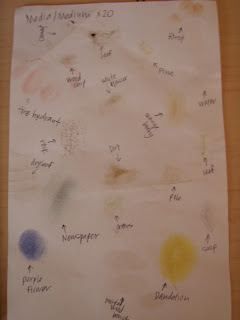Vocabulary:
- Medium/Media: the actual material used to make the mark
- Ground: the surface on which you apply the medium
- Support: whatever the ground is attached to
- Process: the way you apply the media
Possible Activities
- Have kids explore and find different things that make marks on a piece of paper
- Talk about shadows. Even though they are fleeting, do they still count as a mark? The following is a work by Kumi Yamashita who uses unique processes to create incredible art.
- Read the book, "Seven Blind Mice" by Ed Young
- What kinds of media did he use in creating this book?
- What other forms of media would also work?
- Have the kids create their own book to explore the uses of different media.
- Check out the following video for own example of how a child recreated this story by using their own art and recording it.
Example media/ground/support/process:
MEDIA
 |
| There are so many different forms of marks-- allow the kids to think outside the box and have fun with it. |
- cement
- leaf
- rust
- wood chip
- white flower
- pine
- water
- fire hydrant
- rock
- dry leaf
- dirt
- grass
- newspaper
- purple flower
- dandelion
- soap
PROCESSES
- Flick with brush
- Rolling a tire with paint
- Throwing medium at ground
- Computer program
- Covering ground with medium then scrape away what you don't want
- Attach crayons to bottom of door, open and close the door
- Blowing paint/watercolor
- Draw/paint with pen in mouth
- Apply medium to one side of paper, fold in half
- Apply medium to cloth, whip your ground with the cloth
SUPPORTS
- earth
- computer monitor
- refridgerator
- computer keyboard
- house
- lamp
- chest of drawers
- clock
- tree
- table
GROUNDS
- particle board
- metal
- CD case
- clothes
- light bulb
- milk jug
- pillow case
- computer screen
- dirt
- rock

